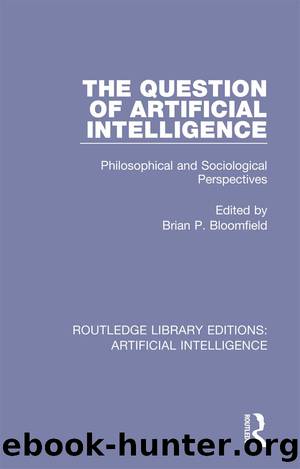The Question of Artificial Intelligence by Brian P. Bloomfield

Author:Brian P. Bloomfield [Bloomfield, Brian P.]
Language: eng
Format: epub
ISBN: 9781138585317
Barnesnoble:
Publisher: Taylor & Francis
Published: 2018-05-14T00:00:00+00:00
A major feature of development in Britain was that the initial AI establishment did not emerge from the strong pre-existing cybernetic or computer science network, despite the clear prefigurement of AI research in the work of Turing and Craik. Rather, it came from people external to such work: Elcock at Aberdeen; Michie, Meltzer, and Longuet-Higgins at Edinburgh; and later, Boden and Sloman at Sussex. Even Sutherland and Clowes at Sussex, although they had links with the cybernetic tradition, were certainly not centrally involved with it. Such an entry into the AI establishment from outside the cybernetics tradition had also been evident in the United States, with Simon and Newell. However, just as was the case in the United States, the first generation members of the British AI establishment, although they were marginal to cybernetics and computer science, certainly did not arrive from nowhere. Michie, for instance, had some 60 publications to his credit in his previous specialist areas of genetics, immunology, and reproduction, and held the post of reader in the Department of Surgical Science at Edinburgh. He was recommended by W.H. Waddington and M. Swann on his appointment to Edinburgh in 1958, and Swann continued to support him during his AI activities. Meltzer, as a reader in the Department of Electrical Engineering, also had a solid reputation for his work on electron beam dynamics (used by NASA for the design of ion propulsion for space vehicles) and solid-state electronics; and Longuet-Higgins, with his international standing in theoretical chemistry was clearly already a member of the wider British scientific establishment.
The migration of outsiders with some standing, and hence the freedom to move fields,127 therefore seems to have had as its major consequence the construction of an organisational structure within which the pursuit of AI research subsequently developed. In some cases (especially that of Sutherland) the organisational leadership role merged with another, probably necessary, role in the emergence of a new interdisciplinary area â namely, a sponsorship role. The institutional developments at Edinburgh would not have been possible without some strong support from sponsors placed in fairly influential positions with the university government, especially in view of the tendency for the publicity attracting, research intensive, AI activities to arouse suspicion and resentment: both Sir Edward Appleton and Sir Michael Swann, who succeeded Appleton as Vice Chancellor of Edinburgh University, were active in encouraging and supporting those developments; and at Sussex, there was also fairly widespread support for AI-oriented developments among many of those in positions of influence.
As well as this positive sponsorship within the wider establishment, which was accompanied by a positive evaluation of the status of AI, there was a negative sponsorship as well, as demonstrated by Sir James Lighthillâs report. Lighthillâs opposition could clearly be seen to support the status quo: he affirmed the value of the currently existing areas included in advanced automation (e.g. control engineering) and in central nervous system research (e.g. neurophysiology), and moreover he attributed any success in AI to contributions arising from these areas.
Download
This site does not store any files on its server. We only index and link to content provided by other sites. Please contact the content providers to delete copyright contents if any and email us, we'll remove relevant links or contents immediately.
Algorithms of the Intelligent Web by Haralambos Marmanis;Dmitry Babenko(16234)
Jquery UI in Action : Master the concepts Of Jquery UI: A Step By Step Approach by ANMOL GOYAL(9386)
Test-Driven Development with Java by Alan Mellor(7735)
Data Augmentation with Python by Duc Haba(7609)
Principles of Data Fabric by Sonia Mezzetta(7378)
Learn Blender Simulations the Right Way by Stephen Pearson(7294)
Microservices with Spring Boot 3 and Spring Cloud by Magnus Larsson(7137)
Hadoop in Practice by Alex Holmes(6587)
RPA Solution Architect's Handbook by Sachin Sahgal(6515)
The Infinite Retina by Robert Scoble Irena Cronin(6216)
Big Data Analysis with Python by Ivan Marin(5933)
Life 3.0: Being Human in the Age of Artificial Intelligence by Tegmark Max(5516)
Pretrain Vision and Large Language Models in Python by Emily Webber(4894)
Infrastructure as Code for Beginners by Russ McKendrick(4653)
Functional Programming in JavaScript by Mantyla Dan(4436)
WordPress Plugin Development Cookbook by Yannick Lefebvre(4382)
The Age of Surveillance Capitalism by Shoshana Zuboff(4245)
Embracing Microservices Design by Ovais Mehboob Ahmed Khan Nabil Siddiqui and Timothy Oleson(4148)
Applied Machine Learning for Healthcare and Life Sciences Using AWS by Ujjwal Ratan(4135)
